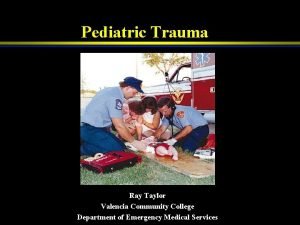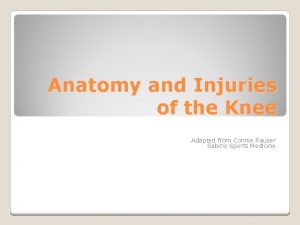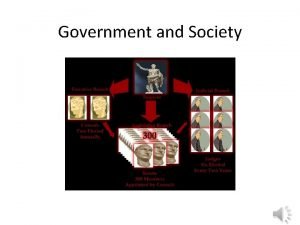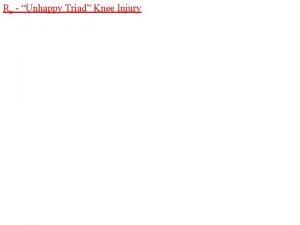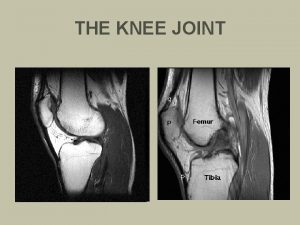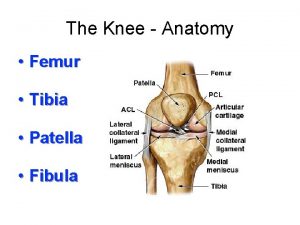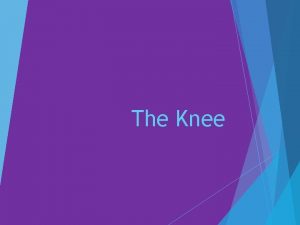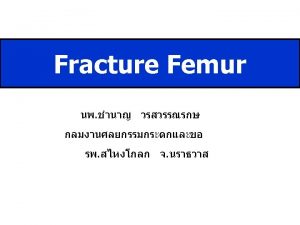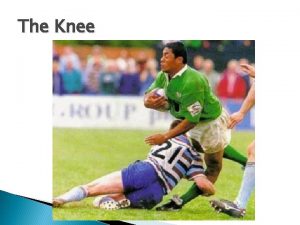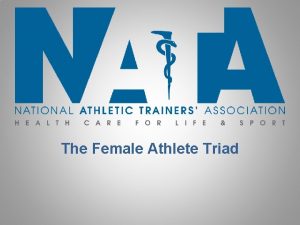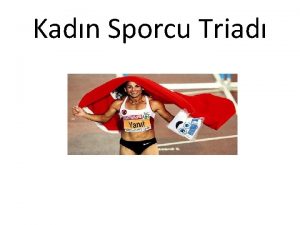Rx Unhappy Triad Knee Injury quadriceps femur quadriceps












- Slides: 12

Rx - “Unhappy Triad” Knee Injury quadriceps femur quadriceps suprapatellar bursa femur articular cartilage anterior cruciate ligament medial collateral ligament lateral meniscus lateral collateral ligament medial meniscus lateral collateral patellar ligament patella articular cartilage prepatellar bursa infrapatellar bursa patellar ligament tibial tuberosity fibula BLOW TO OUTSIDE REAR OF TIBIA posterior cruciate ligament tibia fibula tibia

Rx - “Unhappy Triad” Knee Injury torn medial collatoral ligament torn lateral meniscus torn posterior cruciate ligament

Rx - “Sprained Ankle” -ligaments are overstretched and torn posterior tibiofibular ligament anterior talofibular ligament posterior talofibular ligament calcaneofibular ligament deltoid ligament

Rx - “Sprained Ankle” -ligaments are overstretched and torn anterior talofibular ligament torn calcaneofibular ligament Right foot Anterior view

Rx – Abnormal Curvatures of the Spine 1. Scoliosis -exaggerated lateral thoracic or lumbar curvature -common in fast-growing girls in late childhood, early puberty 2. Kyphosis -exaggerated dorsal thoracic curvature -“hunchback” -common in osteoporotic 3. Lordosis -exaggerated ventral lumbar curvature -“swayback” -common in pregnant women or obese men

Rx –Sinusitis -inflammation of the sinuses, due to infection of bacteria or virus -sinuses are air spaces in the frontal, ethmoid, sphenoid, and maxillary bones -lined with mucous membranes, help warm and moisten air and resonate voice Frontal sinuses Ethmoid sinuses Sphenoid sinuses Maxillary sinuses

Rx –Chondromalacia -“bad cartlilage” -softening or wearing down of cartilage -cartilage under kneecap especially susceptible, especially in female athletes, due to q-angle Rx –Osteoarthritis -“wear-and-tear” arthritis -inflammation of the joint due to wearing down of articular cartilage -triggers cycle of inflammation, pain swelling

Rx –Rheumatoid Arthritis -an autoimmune disease -“How is an autoimmune disease like the Vietnam War? ” -living cells of the synovial membrane are attacked by white blood cells of the immune system, damaged, and progressively replaced by fibrous (scar) tissue, ossified -treated with immunosuppresion Parts of the Vietnam War : : Parts of an Autoimmune Disease Communist North Vietnamese, or Viet. Cong Virus infecting cells of the synovial membrane Vietnamese non-combatant sympathizers Host synovial membrane cells producing viruses Destroying village harboring enemy Cells of the immune system attacking virus Destroying enemy soldiers Cells of the immune system attacking uninfected cells of the synovial membrane Cells of the immune cells attacking virally-infected viral antigen (spike) glycoprotein cells Getting carried away, and killing women, children, and old people virus capsid antigen (spike) envelope viral DNA Virus “recognized” by host cell, like Trojan Horse receptor site ribosomes viral proteins host cell DNA host synovial membrane cell viral DNA

Rx –Bursitis -inflammation of the bursa -usually a chronic overuse injury -“Tennis Elbow” Rx –Osteoporosis -“porous bones” -usually caused by a Vitamin D deficiency Osteoporosis Animation -most common cause of fractures in women over 50 -risk factors include being of Caucasian or East Asian, lack of dietary Calcium, lack of dietary Vitamin D, lack of estrogen in post-menopausal women, lack of exercise, drinking soda, smoking, alcohol use, eating disorders ( immenorrhea lack of estrogen) Rx –Osteomalacia/Ricketts -“bad bones” -usually caused by Calcium deficiency -bones incompletely ossified as child grows, bend under increasing weight, gradually ossified bowlegged deformity

Rx –Fractures -only tissue which heals to be better than it was originally 1. Closed (simple) 2. Compound -broken ends of bone protrude through skin -added risk of nerve damage and infection of muscle and bone 3. Comminuted -bone is fragmented -more common in aged

Rx –Fractures 4. Compression -bone is crushed -more common in osteoporotic, or crushing or car accidents 5. Depressed -broken bone is pressed inward -skull fracture 6. Impacted -broken ends of bone are forced into each other -typical of hip fractures and arm bone fractures when attempting to catch self while falling 7. Spiral -ragged break caused by excessive twisting forces -common in sports injuries

Rx –Fractures 8. Greenstick -bone breaks incompletely, like a green twig breaks -common to children, whose bones contain less compact bone and are more flexible 9. Stress fracture -bone is cracked Rx –Shin Splints -chronic overuse injury 1. 2. 3. 4. Stress fracture -of tibia Stress syndrome -of tibia Tendonitis -of tendons connecting Tibialis anterior to tibia Compartment syndrome -of Tibialis anterior muscle
 Femur femur
Femur femur Muscles for knee flexion
Muscles for knee flexion A spill at parsenn bowl: knee injury and recovery
A spill at parsenn bowl: knee injury and recovery Examples of intentional injury
Examples of intentional injury Unhappy darling
Unhappy darling Animals figures of speech
Animals figures of speech Superlative good
Superlative good Unhappy fortune by my brotherhood
Unhappy fortune by my brotherhood Deka drank
Deka drank If only + past perfect
If only + past perfect A wondering mind is an unhappy mind
A wondering mind is an unhappy mind Romeo and juliet jeopardy
Romeo and juliet jeopardy Government
Government
